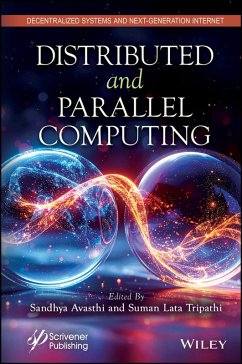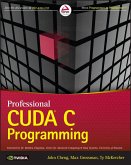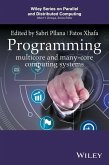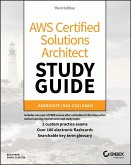Distributed and Parallel Computing (eBook, ePUB)
Redaktion: Avasthi, Sandhya; Tripathi, Suman Lata
168,99 €
168,99 €
inkl. MwSt.
Sofort per Download lieferbar

0 °P sammeln
168,99 €
Als Download kaufen

168,99 €
inkl. MwSt.
Sofort per Download lieferbar

0 °P sammeln
Jetzt verschenken
Alle Infos zum eBook verschenken
168,99 €
inkl. MwSt.
Sofort per Download lieferbar
Alle Infos zum eBook verschenken

0 °P sammeln
Distributed and Parallel Computing (eBook, ePUB)
Redaktion: Avasthi, Sandhya; Tripathi, Suman Lata
- Format: ePub
- Merkliste
- Auf die Merkliste
- Bewerten Bewerten
- Teilen
- Produkt teilen
- Produkterinnerung
- Produkterinnerung

Bitte loggen Sie sich zunächst in Ihr Kundenkonto ein oder registrieren Sie sich bei
bücher.de, um das eBook-Abo tolino select nutzen zu können.
Hier können Sie sich einloggen
Hier können Sie sich einloggen
Sie sind bereits eingeloggt. Klicken Sie auf 2. tolino select Abo, um fortzufahren.

Bitte loggen Sie sich zunächst in Ihr Kundenkonto ein oder registrieren Sie sich bei bücher.de, um das eBook-Abo tolino select nutzen zu können.
Master the growing field of distributed and parallel computing with this essential guide, offering expert insights into the fundamentals and real-world applications for intelligent and collaborative systems.
Distributed computing, or running programs across multiple computers over a network, is becoming a popular solution for addressing the demands for increased performance across industries, including scientific computing, oil exploration, biotechnology, and medicine. Distributed computing enables seamless communication and collaboration by allowing users from different locations to…mehr
- Geräte: eReader
- mit Kopierschutz
- eBook Hilfe
- Größe: 19.02MB
Andere Kunden interessierten sich auch für
![Cyber Security in Parallel and Distributed Computing (eBook, ePUB) Cyber Security in Parallel and Distributed Computing (eBook, ePUB)]() Cyber Security in Parallel and Distributed Computing (eBook, ePUB)197,99 €
Cyber Security in Parallel and Distributed Computing (eBook, ePUB)197,99 €![Professional CUDA C Programming (eBook, ePUB) Professional CUDA C Programming (eBook, ePUB)]() John ChengProfessional CUDA C Programming (eBook, ePUB)38,99 €
John ChengProfessional CUDA C Programming (eBook, ePUB)38,99 €![Programming Multicore and Many-core Computing Systems (eBook, ePUB) Programming Multicore and Many-core Computing Systems (eBook, ePUB)]() Programming Multicore and Many-core Computing Systems (eBook, ePUB)87,99 €
Programming Multicore and Many-core Computing Systems (eBook, ePUB)87,99 €![WordPress All-in-One For Dummies (eBook, ePUB) WordPress All-in-One For Dummies (eBook, ePUB)]() Lisa Sabin-WilsonWordPress All-in-One For Dummies (eBook, ePUB)23,99 €
Lisa Sabin-WilsonWordPress All-in-One For Dummies (eBook, ePUB)23,99 €![Networking Fundamentals (eBook, ePUB) Networking Fundamentals (eBook, ePUB)]() Crystal PanekNetworking Fundamentals (eBook, ePUB)28,99 €
Crystal PanekNetworking Fundamentals (eBook, ePUB)28,99 €![AWS Certified Solutions Architect Study Guide (eBook, ePUB) AWS Certified Solutions Architect Study Guide (eBook, ePUB)]() Ben PiperAWS Certified Solutions Architect Study Guide (eBook, ePUB)38,99 €
Ben PiperAWS Certified Solutions Architect Study Guide (eBook, ePUB)38,99 €![HTML5 and CSS3 All-in-One For Dummies (eBook, ePUB) HTML5 and CSS3 All-in-One For Dummies (eBook, ePUB)]() Andy HarrisHTML5 and CSS3 All-in-One For Dummies (eBook, ePUB)27,99 €
Andy HarrisHTML5 and CSS3 All-in-One For Dummies (eBook, ePUB)27,99 €-
-
-
Master the growing field of distributed and parallel computing with this essential guide, offering expert insights into the fundamentals and real-world applications for intelligent and collaborative systems.
Distributed computing, or running programs across multiple computers over a network, is becoming a popular solution for addressing the demands for increased performance across industries, including scientific computing, oil exploration, biotechnology, and medicine. Distributed computing enables seamless communication and collaboration by allowing users from different locations to access and interact with their digital twin simultaneously. Distributed computing enhances the capabilities of digital twins by providing scalability, parallel processing, real-time data integration, collaboration support, resource optimization, fault tolerance, and security features. Distributed and Parallel Computing explores the fundamentals and innovations in intelligent and distributed computing systems and applications, including adaptivity and learning, agents and multi-agent systems, argumentation, case-based reasoning, and collaborative systems. Through expert insights, readers will discover promising real-world applications for this emerging technology.
Distributed computing, or running programs across multiple computers over a network, is becoming a popular solution for addressing the demands for increased performance across industries, including scientific computing, oil exploration, biotechnology, and medicine. Distributed computing enables seamless communication and collaboration by allowing users from different locations to access and interact with their digital twin simultaneously. Distributed computing enhances the capabilities of digital twins by providing scalability, parallel processing, real-time data integration, collaboration support, resource optimization, fault tolerance, and security features. Distributed and Parallel Computing explores the fundamentals and innovations in intelligent and distributed computing systems and applications, including adaptivity and learning, agents and multi-agent systems, argumentation, case-based reasoning, and collaborative systems. Through expert insights, readers will discover promising real-world applications for this emerging technology.
Dieser Download kann aus rechtlichen Gründen nur mit Rechnungsadresse in D ausgeliefert werden.
Produktdetails
- Produktdetails
- Verlag: Wiley-ISTE
- Seitenzahl: 524
- Erscheinungstermin: 10. November 2025
- Englisch
- ISBN-13: 9781394288014
- Artikelnr.: 75869216
- Verlag: Wiley-ISTE
- Seitenzahl: 524
- Erscheinungstermin: 10. November 2025
- Englisch
- ISBN-13: 9781394288014
- Artikelnr.: 75869216
- Herstellerkennzeichnung Die Herstellerinformationen sind derzeit nicht verfügbar.
Sandhya Avasthi, PhD is an assistant professor in the Computer Science and Engineering Department at ABES Engineering College at Dr. Abdul Kalam Technical University with over 18 years of teaching experience. She has published numerous research articles in refereed international journals, conference proceedings, and book chapters. Her research interests include natural language processing, information extraction, information retrieval, data science, and business intelligence. Suman Lata Tripathi, PhD is a professor at Lovely Professional University with more than 22 years of experience in academics and research. She has published more than 19 books, 125 research papers in refereed science journals, conference proceedings, 13 Indian patents, and four copyrights. Her area of expertise includes microelectronics device modeling and characterization, low-power VLSI circuit design, VLSI design testing, and advanced FET design for IoT.
Preface xvii
1 Introduction to Distributed Systems 1
K. Karthikeyan, S. Hemalatha and S. Vignesh
1.1 Introduction 2
2 Topology in Network Technologies 39
Mohit Malik, Varun Dogra, Ramandeep Sandhu, Ratesh Kumar and Deepika Ghai
2.1 Introduction 40
2.2 Related Work 41
2.3 Network Topology Design 44
2.4 Advantages of Network Topologies 47
2.5 Case Studies of Network Topologies 48
2.6 Distributed and Parallel Computing in Network Topology 49
2.7 Conclusion 53
3 Distributed Processing Technology and Advancements 57
Saranya. N., Shermy. R.P., Sindhu. V., Karthika Renuka. D. and Renugadevi.
G.
3.1 Introduction 58
3.2 Distributed Processing in Modern Computing 60
3.3 Evolution of Distributed Processing 61
3.4 Key Concepts and Technologies Driving the Evolution of Distributed
Processing 63
3.5 Recent Advancements in Distributed Processing 64
3.6 Changing Landscape of Computing 65
3.7 Security and Privacy Considerations 68
3.8 Opportunities and Challenges in Distributed Computing 71
3.9 Conclusion 73
4 Distributed System Architecture and Computing Models 77
Sandhya Avasthi and Suman Lata Tripathi
4.1 Introduction 77
4.2 Distributed System Architecture 78
4.3 Middleware in Distributed Systems 85
4.4 Distributed Cloud Architecture 88
4.5 Distributed Machine Learning 90
4.6 Conclusion 91
5 Parallel Computing Models and Architecture 95
Aastha Sharma, Swati Sharma and Divya Mishra
5.1 Introduction 96
5.2 Evolution of Parallel Computing Models 98
5.3 Parallel Computing Models 100
6 Network Issues and High-Level Communication Tools in Distributed
Computing 115
Sandhya Avasthi and Sachin Kumar Vishwakarma
6.1 Introduction 116
6.2 Latency in Distributed and Parallel Computing 118
6.3 Straggler Effect 122
6.4 Packet Loss in the Distributed Network 125
6.5 Network Congestion 128
6.6 Communication Load 129
6.7 Conclusion 132
7 Infinite Horizons: Empowering Business Education Through Metaverse 135
Shikha Mishra and Sujit S. Nair
7.1 Introduction 136
7.2 Challenges and Concerns 137
7.3 Rules of Law-Based Governance 139
7.4 Possible Implementations in Educational Framework of Metaverse
Technology 140
7.5 Understanding Metaverse 141
7.6 Explore the Transformational Potential of Metaverse for Business
Education 142
7.7 Innovation and Design Ideas Forum 145
7.8 Continuing Education and Career Development 147
7.9 Takeaways 147
7.10 Ethical and Legal Issues 148
7.11 Future Prospects and Innovations 149
7.12 Conclusion 149
8 Paradigm Shifts and Future Directions in Distributed Data Management for
Decentralized Networks 153
Bishnu Kant Shukla, Bhupender Parashar, Vikas Kumar Singla and Shivam Verma
8.1 Introduction 154
8.2 Paradigm Shifts in Distributed Data Management 155
8.3 Emergent Architectures and Frameworks 156
8.4 Integration of IoT 160
8.5 Edge Computing and Big Data Analytics 163
8.6 Data Aggregation and Summarization Techniques 164
8.7 Advanced Applications and Case Studies 168
8.8 Future Directions in Distributed Data Management 172
8.9 Conclusion 174
9 Autonomy and Adaptive Architectures in Distributed Systems 183
Bishnu Kant Shukla, Bhupender Parashar, Vikas Kumar Singla and Shivam Verma
9.1 Introduction 184
9.2 Conceptual Framework 185
9.3 Architectural Models 187
9.4 Adaptive Strategies in Distributed Systems 188
9.5 Case Studies 191
9.6 Application of MASs 195
9.7 Autonomous Navigation Systems 199
9.8 Collision Avoidance Algorithms 202
9.9 Network Properties in Distributed Systems 206
9.10 Challenges and Future Directions 207
9.11 Conclusion 210
10 Distributed Consensus Frequency Control in Networked Microgrid 219
Jeevitha Kandasamy, J. Jenitha, M.R. Mohanraj, Jenifer Amla. L., G.
Mahalakshmi and Ponrekha M.
10.1 Introduction 220
10.2 System Model 224
10.3 Distributed Control Technique 225
10.4 Results and Discussion 228
10.5 Conclusion 231
11 Navigating Trust in Distributed Systems 235
Pooja Dehankar and Susanta Das
11.1 Introduction 236
11.2 Transparency Basics 240
11.3 Heterogeneous and Homogeneous DSs 240
11.4 Trust Management 242
11.5 Components' Roles 243
11.6 User Authentication and Access Control 244
11.7 Trust Framework Pillars 244
11.8 Trust Metrics 244
11.9 Trust Models and Mechanisms 245
11.10 Trust in Sensor Networks 247
11.11 Apps of TMSs 248
11.12 DSs Advantages and Challenges 249
11.13 Artificial Intelligence for Trust Management 250
11.14 Conclusion 251
12 Trust in Distributed Systems, Distributed Ledger, Blockchain, and
Related Technologies 257
Shikha Verma, Priya Mishra and Sandhya Avasthi
12.1 Introduction 257
12.2 Trust in Distributed Ledger 258
12.3 Trust Management in Edge-Based IoT Systems 260
12.4 A Taxonomy of Trust Computation Frameworks for Edge-Based IoT Systems
261
12.5 Trust in Distributed Databases 262
12.6 Trust in Blockchain 263
12.7 Serverless Computing 268
12.8 Trust in Cloud Computing 273
12.9 Conclusion 275
13 Strategy to Improve Psychological Elements and Customer Service in
Intelligent Health Systems 281
Mani Dublish, Anita Pati Mishra and Shikha Mittal
13.1 Introduction 282
13.2 Design with User in Mind 284
13.3 Designing Networked Medication Equipment with a Human Center 285
13.4 Testing Usability with End Users 285
13.5 Framework Required in Healthcare Fiction for Human-Based Design 287
13.6 A Necessary Step to Enable Quick Learning Processes 287
13.7 Requirement for a Planned Approach Setup 288
13.8 Limitations 291
13.9 Conclusion 292
14 New Age Techs Backbone: Role of Distributed Systems in Paving Path for a
Durable Future 299
Kadambri Agarwal and Saijal Dahiya
14.1 Introduction 300
14.2 Distributed Systems in Smart Grids 303
14.3 Distributed Systems in IoT 305
14.4 Distributed Systems in Blockchain 308
14.5 Distributed Systems in Machine Learning 310
14.6 Distributed Systems in AR 313
14.7 Distributed Systems in Distributed Databases 315
14.8 Distributed Systems in Metaverse 317
14.9 Conclusion 320
15 Power Optimization in 4Bit Comparator Architecture Through
Precomputation Technique 323
Adarsh Sharma, Suman Lata Tripathi, Deepika Ghai and Khilda Afifah
15.1 Introduction 324
15.2 Comparator 327
15.3 Precomputation Technique 328
15.4 Reported Precomputation Circuit 329
15.5 Comparator Design with Cadence Virtuoso 330
15.6 Future Scopes 331
15.7 Conclusion 335
Acknowledgement 335
References 335
Index 339
1 Introduction to Distributed Systems 1
K. Karthikeyan, S. Hemalatha and S. Vignesh
1.1 Introduction 2
2 Topology in Network Technologies 39
Mohit Malik, Varun Dogra, Ramandeep Sandhu, Ratesh Kumar and Deepika Ghai
2.1 Introduction 40
2.2 Related Work 41
2.3 Network Topology Design 44
2.4 Advantages of Network Topologies 47
2.5 Case Studies of Network Topologies 48
2.6 Distributed and Parallel Computing in Network Topology 49
2.7 Conclusion 53
3 Distributed Processing Technology and Advancements 57
Saranya. N., Shermy. R.P., Sindhu. V., Karthika Renuka. D. and Renugadevi.
G.
3.1 Introduction 58
3.2 Distributed Processing in Modern Computing 60
3.3 Evolution of Distributed Processing 61
3.4 Key Concepts and Technologies Driving the Evolution of Distributed
Processing 63
3.5 Recent Advancements in Distributed Processing 64
3.6 Changing Landscape of Computing 65
3.7 Security and Privacy Considerations 68
3.8 Opportunities and Challenges in Distributed Computing 71
3.9 Conclusion 73
4 Distributed System Architecture and Computing Models 77
Sandhya Avasthi and Suman Lata Tripathi
4.1 Introduction 77
4.2 Distributed System Architecture 78
4.3 Middleware in Distributed Systems 85
4.4 Distributed Cloud Architecture 88
4.5 Distributed Machine Learning 90
4.6 Conclusion 91
5 Parallel Computing Models and Architecture 95
Aastha Sharma, Swati Sharma and Divya Mishra
5.1 Introduction 96
5.2 Evolution of Parallel Computing Models 98
5.3 Parallel Computing Models 100
6 Network Issues and High-Level Communication Tools in Distributed
Computing 115
Sandhya Avasthi and Sachin Kumar Vishwakarma
6.1 Introduction 116
6.2 Latency in Distributed and Parallel Computing 118
6.3 Straggler Effect 122
6.4 Packet Loss in the Distributed Network 125
6.5 Network Congestion 128
6.6 Communication Load 129
6.7 Conclusion 132
7 Infinite Horizons: Empowering Business Education Through Metaverse 135
Shikha Mishra and Sujit S. Nair
7.1 Introduction 136
7.2 Challenges and Concerns 137
7.3 Rules of Law-Based Governance 139
7.4 Possible Implementations in Educational Framework of Metaverse
Technology 140
7.5 Understanding Metaverse 141
7.6 Explore the Transformational Potential of Metaverse for Business
Education 142
7.7 Innovation and Design Ideas Forum 145
7.8 Continuing Education and Career Development 147
7.9 Takeaways 147
7.10 Ethical and Legal Issues 148
7.11 Future Prospects and Innovations 149
7.12 Conclusion 149
8 Paradigm Shifts and Future Directions in Distributed Data Management for
Decentralized Networks 153
Bishnu Kant Shukla, Bhupender Parashar, Vikas Kumar Singla and Shivam Verma
8.1 Introduction 154
8.2 Paradigm Shifts in Distributed Data Management 155
8.3 Emergent Architectures and Frameworks 156
8.4 Integration of IoT 160
8.5 Edge Computing and Big Data Analytics 163
8.6 Data Aggregation and Summarization Techniques 164
8.7 Advanced Applications and Case Studies 168
8.8 Future Directions in Distributed Data Management 172
8.9 Conclusion 174
9 Autonomy and Adaptive Architectures in Distributed Systems 183
Bishnu Kant Shukla, Bhupender Parashar, Vikas Kumar Singla and Shivam Verma
9.1 Introduction 184
9.2 Conceptual Framework 185
9.3 Architectural Models 187
9.4 Adaptive Strategies in Distributed Systems 188
9.5 Case Studies 191
9.6 Application of MASs 195
9.7 Autonomous Navigation Systems 199
9.8 Collision Avoidance Algorithms 202
9.9 Network Properties in Distributed Systems 206
9.10 Challenges and Future Directions 207
9.11 Conclusion 210
10 Distributed Consensus Frequency Control in Networked Microgrid 219
Jeevitha Kandasamy, J. Jenitha, M.R. Mohanraj, Jenifer Amla. L., G.
Mahalakshmi and Ponrekha M.
10.1 Introduction 220
10.2 System Model 224
10.3 Distributed Control Technique 225
10.4 Results and Discussion 228
10.5 Conclusion 231
11 Navigating Trust in Distributed Systems 235
Pooja Dehankar and Susanta Das
11.1 Introduction 236
11.2 Transparency Basics 240
11.3 Heterogeneous and Homogeneous DSs 240
11.4 Trust Management 242
11.5 Components' Roles 243
11.6 User Authentication and Access Control 244
11.7 Trust Framework Pillars 244
11.8 Trust Metrics 244
11.9 Trust Models and Mechanisms 245
11.10 Trust in Sensor Networks 247
11.11 Apps of TMSs 248
11.12 DSs Advantages and Challenges 249
11.13 Artificial Intelligence for Trust Management 250
11.14 Conclusion 251
12 Trust in Distributed Systems, Distributed Ledger, Blockchain, and
Related Technologies 257
Shikha Verma, Priya Mishra and Sandhya Avasthi
12.1 Introduction 257
12.2 Trust in Distributed Ledger 258
12.3 Trust Management in Edge-Based IoT Systems 260
12.4 A Taxonomy of Trust Computation Frameworks for Edge-Based IoT Systems
261
12.5 Trust in Distributed Databases 262
12.6 Trust in Blockchain 263
12.7 Serverless Computing 268
12.8 Trust in Cloud Computing 273
12.9 Conclusion 275
13 Strategy to Improve Psychological Elements and Customer Service in
Intelligent Health Systems 281
Mani Dublish, Anita Pati Mishra and Shikha Mittal
13.1 Introduction 282
13.2 Design with User in Mind 284
13.3 Designing Networked Medication Equipment with a Human Center 285
13.4 Testing Usability with End Users 285
13.5 Framework Required in Healthcare Fiction for Human-Based Design 287
13.6 A Necessary Step to Enable Quick Learning Processes 287
13.7 Requirement for a Planned Approach Setup 288
13.8 Limitations 291
13.9 Conclusion 292
14 New Age Techs Backbone: Role of Distributed Systems in Paving Path for a
Durable Future 299
Kadambri Agarwal and Saijal Dahiya
14.1 Introduction 300
14.2 Distributed Systems in Smart Grids 303
14.3 Distributed Systems in IoT 305
14.4 Distributed Systems in Blockchain 308
14.5 Distributed Systems in Machine Learning 310
14.6 Distributed Systems in AR 313
14.7 Distributed Systems in Distributed Databases 315
14.8 Distributed Systems in Metaverse 317
14.9 Conclusion 320
15 Power Optimization in 4Bit Comparator Architecture Through
Precomputation Technique 323
Adarsh Sharma, Suman Lata Tripathi, Deepika Ghai and Khilda Afifah
15.1 Introduction 324
15.2 Comparator 327
15.3 Precomputation Technique 328
15.4 Reported Precomputation Circuit 329
15.5 Comparator Design with Cadence Virtuoso 330
15.6 Future Scopes 331
15.7 Conclusion 335
Acknowledgement 335
References 335
Index 339
Preface xvii
1 Introduction to Distributed Systems 1
K. Karthikeyan, S. Hemalatha and S. Vignesh
1.1 Introduction 2
2 Topology in Network Technologies 39
Mohit Malik, Varun Dogra, Ramandeep Sandhu, Ratesh Kumar and Deepika Ghai
2.1 Introduction 40
2.2 Related Work 41
2.3 Network Topology Design 44
2.4 Advantages of Network Topologies 47
2.5 Case Studies of Network Topologies 48
2.6 Distributed and Parallel Computing in Network Topology 49
2.7 Conclusion 53
3 Distributed Processing Technology and Advancements 57
Saranya. N., Shermy. R.P., Sindhu. V., Karthika Renuka. D. and Renugadevi.
G.
3.1 Introduction 58
3.2 Distributed Processing in Modern Computing 60
3.3 Evolution of Distributed Processing 61
3.4 Key Concepts and Technologies Driving the Evolution of Distributed
Processing 63
3.5 Recent Advancements in Distributed Processing 64
3.6 Changing Landscape of Computing 65
3.7 Security and Privacy Considerations 68
3.8 Opportunities and Challenges in Distributed Computing 71
3.9 Conclusion 73
4 Distributed System Architecture and Computing Models 77
Sandhya Avasthi and Suman Lata Tripathi
4.1 Introduction 77
4.2 Distributed System Architecture 78
4.3 Middleware in Distributed Systems 85
4.4 Distributed Cloud Architecture 88
4.5 Distributed Machine Learning 90
4.6 Conclusion 91
5 Parallel Computing Models and Architecture 95
Aastha Sharma, Swati Sharma and Divya Mishra
5.1 Introduction 96
5.2 Evolution of Parallel Computing Models 98
5.3 Parallel Computing Models 100
6 Network Issues and High-Level Communication Tools in Distributed
Computing 115
Sandhya Avasthi and Sachin Kumar Vishwakarma
6.1 Introduction 116
6.2 Latency in Distributed and Parallel Computing 118
6.3 Straggler Effect 122
6.4 Packet Loss in the Distributed Network 125
6.5 Network Congestion 128
6.6 Communication Load 129
6.7 Conclusion 132
7 Infinite Horizons: Empowering Business Education Through Metaverse 135
Shikha Mishra and Sujit S. Nair
7.1 Introduction 136
7.2 Challenges and Concerns 137
7.3 Rules of Law-Based Governance 139
7.4 Possible Implementations in Educational Framework of Metaverse
Technology 140
7.5 Understanding Metaverse 141
7.6 Explore the Transformational Potential of Metaverse for Business
Education 142
7.7 Innovation and Design Ideas Forum 145
7.8 Continuing Education and Career Development 147
7.9 Takeaways 147
7.10 Ethical and Legal Issues 148
7.11 Future Prospects and Innovations 149
7.12 Conclusion 149
8 Paradigm Shifts and Future Directions in Distributed Data Management for
Decentralized Networks 153
Bishnu Kant Shukla, Bhupender Parashar, Vikas Kumar Singla and Shivam Verma
8.1 Introduction 154
8.2 Paradigm Shifts in Distributed Data Management 155
8.3 Emergent Architectures and Frameworks 156
8.4 Integration of IoT 160
8.5 Edge Computing and Big Data Analytics 163
8.6 Data Aggregation and Summarization Techniques 164
8.7 Advanced Applications and Case Studies 168
8.8 Future Directions in Distributed Data Management 172
8.9 Conclusion 174
9 Autonomy and Adaptive Architectures in Distributed Systems 183
Bishnu Kant Shukla, Bhupender Parashar, Vikas Kumar Singla and Shivam Verma
9.1 Introduction 184
9.2 Conceptual Framework 185
9.3 Architectural Models 187
9.4 Adaptive Strategies in Distributed Systems 188
9.5 Case Studies 191
9.6 Application of MASs 195
9.7 Autonomous Navigation Systems 199
9.8 Collision Avoidance Algorithms 202
9.9 Network Properties in Distributed Systems 206
9.10 Challenges and Future Directions 207
9.11 Conclusion 210
10 Distributed Consensus Frequency Control in Networked Microgrid 219
Jeevitha Kandasamy, J. Jenitha, M.R. Mohanraj, Jenifer Amla. L., G.
Mahalakshmi and Ponrekha M.
10.1 Introduction 220
10.2 System Model 224
10.3 Distributed Control Technique 225
10.4 Results and Discussion 228
10.5 Conclusion 231
11 Navigating Trust in Distributed Systems 235
Pooja Dehankar and Susanta Das
11.1 Introduction 236
11.2 Transparency Basics 240
11.3 Heterogeneous and Homogeneous DSs 240
11.4 Trust Management 242
11.5 Components' Roles 243
11.6 User Authentication and Access Control 244
11.7 Trust Framework Pillars 244
11.8 Trust Metrics 244
11.9 Trust Models and Mechanisms 245
11.10 Trust in Sensor Networks 247
11.11 Apps of TMSs 248
11.12 DSs Advantages and Challenges 249
11.13 Artificial Intelligence for Trust Management 250
11.14 Conclusion 251
12 Trust in Distributed Systems, Distributed Ledger, Blockchain, and
Related Technologies 257
Shikha Verma, Priya Mishra and Sandhya Avasthi
12.1 Introduction 257
12.2 Trust in Distributed Ledger 258
12.3 Trust Management in Edge-Based IoT Systems 260
12.4 A Taxonomy of Trust Computation Frameworks for Edge-Based IoT Systems
261
12.5 Trust in Distributed Databases 262
12.6 Trust in Blockchain 263
12.7 Serverless Computing 268
12.8 Trust in Cloud Computing 273
12.9 Conclusion 275
13 Strategy to Improve Psychological Elements and Customer Service in
Intelligent Health Systems 281
Mani Dublish, Anita Pati Mishra and Shikha Mittal
13.1 Introduction 282
13.2 Design with User in Mind 284
13.3 Designing Networked Medication Equipment with a Human Center 285
13.4 Testing Usability with End Users 285
13.5 Framework Required in Healthcare Fiction for Human-Based Design 287
13.6 A Necessary Step to Enable Quick Learning Processes 287
13.7 Requirement for a Planned Approach Setup 288
13.8 Limitations 291
13.9 Conclusion 292
14 New Age Techs Backbone: Role of Distributed Systems in Paving Path for a
Durable Future 299
Kadambri Agarwal and Saijal Dahiya
14.1 Introduction 300
14.2 Distributed Systems in Smart Grids 303
14.3 Distributed Systems in IoT 305
14.4 Distributed Systems in Blockchain 308
14.5 Distributed Systems in Machine Learning 310
14.6 Distributed Systems in AR 313
14.7 Distributed Systems in Distributed Databases 315
14.8 Distributed Systems in Metaverse 317
14.9 Conclusion 320
15 Power Optimization in 4Bit Comparator Architecture Through
Precomputation Technique 323
Adarsh Sharma, Suman Lata Tripathi, Deepika Ghai and Khilda Afifah
15.1 Introduction 324
15.2 Comparator 327
15.3 Precomputation Technique 328
15.4 Reported Precomputation Circuit 329
15.5 Comparator Design with Cadence Virtuoso 330
15.6 Future Scopes 331
15.7 Conclusion 335
Acknowledgement 335
References 335
Index 339
1 Introduction to Distributed Systems 1
K. Karthikeyan, S. Hemalatha and S. Vignesh
1.1 Introduction 2
2 Topology in Network Technologies 39
Mohit Malik, Varun Dogra, Ramandeep Sandhu, Ratesh Kumar and Deepika Ghai
2.1 Introduction 40
2.2 Related Work 41
2.3 Network Topology Design 44
2.4 Advantages of Network Topologies 47
2.5 Case Studies of Network Topologies 48
2.6 Distributed and Parallel Computing in Network Topology 49
2.7 Conclusion 53
3 Distributed Processing Technology and Advancements 57
Saranya. N., Shermy. R.P., Sindhu. V., Karthika Renuka. D. and Renugadevi.
G.
3.1 Introduction 58
3.2 Distributed Processing in Modern Computing 60
3.3 Evolution of Distributed Processing 61
3.4 Key Concepts and Technologies Driving the Evolution of Distributed
Processing 63
3.5 Recent Advancements in Distributed Processing 64
3.6 Changing Landscape of Computing 65
3.7 Security and Privacy Considerations 68
3.8 Opportunities and Challenges in Distributed Computing 71
3.9 Conclusion 73
4 Distributed System Architecture and Computing Models 77
Sandhya Avasthi and Suman Lata Tripathi
4.1 Introduction 77
4.2 Distributed System Architecture 78
4.3 Middleware in Distributed Systems 85
4.4 Distributed Cloud Architecture 88
4.5 Distributed Machine Learning 90
4.6 Conclusion 91
5 Parallel Computing Models and Architecture 95
Aastha Sharma, Swati Sharma and Divya Mishra
5.1 Introduction 96
5.2 Evolution of Parallel Computing Models 98
5.3 Parallel Computing Models 100
6 Network Issues and High-Level Communication Tools in Distributed
Computing 115
Sandhya Avasthi and Sachin Kumar Vishwakarma
6.1 Introduction 116
6.2 Latency in Distributed and Parallel Computing 118
6.3 Straggler Effect 122
6.4 Packet Loss in the Distributed Network 125
6.5 Network Congestion 128
6.6 Communication Load 129
6.7 Conclusion 132
7 Infinite Horizons: Empowering Business Education Through Metaverse 135
Shikha Mishra and Sujit S. Nair
7.1 Introduction 136
7.2 Challenges and Concerns 137
7.3 Rules of Law-Based Governance 139
7.4 Possible Implementations in Educational Framework of Metaverse
Technology 140
7.5 Understanding Metaverse 141
7.6 Explore the Transformational Potential of Metaverse for Business
Education 142
7.7 Innovation and Design Ideas Forum 145
7.8 Continuing Education and Career Development 147
7.9 Takeaways 147
7.10 Ethical and Legal Issues 148
7.11 Future Prospects and Innovations 149
7.12 Conclusion 149
8 Paradigm Shifts and Future Directions in Distributed Data Management for
Decentralized Networks 153
Bishnu Kant Shukla, Bhupender Parashar, Vikas Kumar Singla and Shivam Verma
8.1 Introduction 154
8.2 Paradigm Shifts in Distributed Data Management 155
8.3 Emergent Architectures and Frameworks 156
8.4 Integration of IoT 160
8.5 Edge Computing and Big Data Analytics 163
8.6 Data Aggregation and Summarization Techniques 164
8.7 Advanced Applications and Case Studies 168
8.8 Future Directions in Distributed Data Management 172
8.9 Conclusion 174
9 Autonomy and Adaptive Architectures in Distributed Systems 183
Bishnu Kant Shukla, Bhupender Parashar, Vikas Kumar Singla and Shivam Verma
9.1 Introduction 184
9.2 Conceptual Framework 185
9.3 Architectural Models 187
9.4 Adaptive Strategies in Distributed Systems 188
9.5 Case Studies 191
9.6 Application of MASs 195
9.7 Autonomous Navigation Systems 199
9.8 Collision Avoidance Algorithms 202
9.9 Network Properties in Distributed Systems 206
9.10 Challenges and Future Directions 207
9.11 Conclusion 210
10 Distributed Consensus Frequency Control in Networked Microgrid 219
Jeevitha Kandasamy, J. Jenitha, M.R. Mohanraj, Jenifer Amla. L., G.
Mahalakshmi and Ponrekha M.
10.1 Introduction 220
10.2 System Model 224
10.3 Distributed Control Technique 225
10.4 Results and Discussion 228
10.5 Conclusion 231
11 Navigating Trust in Distributed Systems 235
Pooja Dehankar and Susanta Das
11.1 Introduction 236
11.2 Transparency Basics 240
11.3 Heterogeneous and Homogeneous DSs 240
11.4 Trust Management 242
11.5 Components' Roles 243
11.6 User Authentication and Access Control 244
11.7 Trust Framework Pillars 244
11.8 Trust Metrics 244
11.9 Trust Models and Mechanisms 245
11.10 Trust in Sensor Networks 247
11.11 Apps of TMSs 248
11.12 DSs Advantages and Challenges 249
11.13 Artificial Intelligence for Trust Management 250
11.14 Conclusion 251
12 Trust in Distributed Systems, Distributed Ledger, Blockchain, and
Related Technologies 257
Shikha Verma, Priya Mishra and Sandhya Avasthi
12.1 Introduction 257
12.2 Trust in Distributed Ledger 258
12.3 Trust Management in Edge-Based IoT Systems 260
12.4 A Taxonomy of Trust Computation Frameworks for Edge-Based IoT Systems
261
12.5 Trust in Distributed Databases 262
12.6 Trust in Blockchain 263
12.7 Serverless Computing 268
12.8 Trust in Cloud Computing 273
12.9 Conclusion 275
13 Strategy to Improve Psychological Elements and Customer Service in
Intelligent Health Systems 281
Mani Dublish, Anita Pati Mishra and Shikha Mittal
13.1 Introduction 282
13.2 Design with User in Mind 284
13.3 Designing Networked Medication Equipment with a Human Center 285
13.4 Testing Usability with End Users 285
13.5 Framework Required in Healthcare Fiction for Human-Based Design 287
13.6 A Necessary Step to Enable Quick Learning Processes 287
13.7 Requirement for a Planned Approach Setup 288
13.8 Limitations 291
13.9 Conclusion 292
14 New Age Techs Backbone: Role of Distributed Systems in Paving Path for a
Durable Future 299
Kadambri Agarwal and Saijal Dahiya
14.1 Introduction 300
14.2 Distributed Systems in Smart Grids 303
14.3 Distributed Systems in IoT 305
14.4 Distributed Systems in Blockchain 308
14.5 Distributed Systems in Machine Learning 310
14.6 Distributed Systems in AR 313
14.7 Distributed Systems in Distributed Databases 315
14.8 Distributed Systems in Metaverse 317
14.9 Conclusion 320
15 Power Optimization in 4Bit Comparator Architecture Through
Precomputation Technique 323
Adarsh Sharma, Suman Lata Tripathi, Deepika Ghai and Khilda Afifah
15.1 Introduction 324
15.2 Comparator 327
15.3 Precomputation Technique 328
15.4 Reported Precomputation Circuit 329
15.5 Comparator Design with Cadence Virtuoso 330
15.6 Future Scopes 331
15.7 Conclusion 335
Acknowledgement 335
References 335
Index 339







